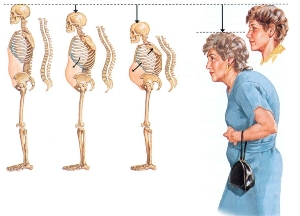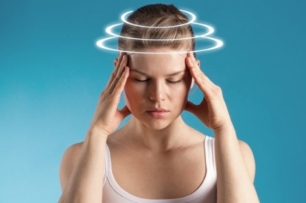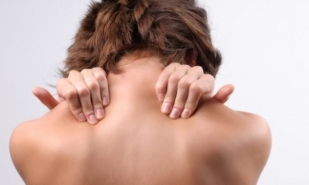Cervical osteochondrosis – a disease of the spine the pillar, which arise from degenerative changes in the intervertebral disks. In the first stage of development of the symptoms are almost unnoticeable, but when it comes to the spread of unhealthy process, the patient's condition is deteriorating.

The causes of the disease
Osteochondrosis arises as a result of uneven load on the spine. Precipitating factors:
- heavy physical activity;
- wearing the wrong shoes;
- defective food;
- problems with the exchange processes;
- nervous and emotional exhaustion.
The disease can occur during bearing a child. The big risk in a multiple pregnancy. The disease process may be genetically conditioned.
Stage of development and photo
The development of degenerative disc disease is slow. There are 4 main phases of the disease:
- The first phase of the. The patient feels discomfort during a longer walk and stay in one position. Begin to form the seal vertebral discs.
- The second phase of the. Arise from feelings of pain. The doctor prescribes manual therapy and analgesics.
- The third stage of the. Observed expressed degenerative changes in the intervertebral disks.
- The fourth phase. The final stage of the development of the disease in which to wonder, virtually all departments of the spine.

In the last stages of conservative therapy will be ineffective. The doctor will prescribe to carry out a surgical procedure that will require a long recovery.
The total symptoms
Osteochondrosis may cover one or more departments of the spine. Most often affects the vertebrae of the cervical. The clinical symptoms are of such a deviation is directly related to the work of the brain. Consider all the main symptoms of this disease.
Pain in the back of the head, neck and collar zone
Patients often appear pain in the neck, the occipital and the collar zone. It arises due to insufficient blood circulation in the brain. Deformation of the vertebrae leading to compression of the vertebral artery. On the background of these degenerative processes can occur hernia.
Together with pain feelings, creates the danger of serious complications. For example, disorders of blood pressure or permanent disturbances of hearing and vision. Sometimes the patient experiences bouts of panic and anxiety. Can take up to 30 minutes. Such a condition called diencephalic syndrome.
Another reason painful feelings – a spasm of the muscles, which leads to a reduction in blood flow. The patient may temporarily lose the ability to twist his neck. The strong strain leads to the fact that the feelings of pain from the neck will start to flow in the back of the head and can spread further on his head. As a result of these processes, a patient suffering from a powerful migraine.
Noise, ringing, a feeling of congestion in the ears

This complex of symptoms is called the cochlear or cochlear. Doctors are not always able to associate such deviations with the development of cervical degenerative disc disease.
Noise and ringing in the ears arises when change of state or a long-term stay in one position.
Vertigo
The vertebrae of the neck thin enough, so when holding the head, which are exposed to strong loads. They are more susceptible to deformation than the vertebrae of the thoracic department. Due to the deviations arise dizziness, which can be:
- System. Is present a feeling of circular movement of the body and the surrounding objects. It occurs because of errors in the work of the vestibular organs, muscles and receptors in the joints.
- It is not systemic. The patient is present a feeling of nausea, stun and you are not sure of the condition in the upright position. The feeling of circular rotation is missing.
Upon the occurrence of this symptom, it is necessary to immediately seek medical help. The reasons for the emergency hospitalization of the patient:
- numbness of the shoulder;
- paralysis of the facial muscles;
- loss of consciousness;
- severe headache.
The Offset vertebra and spasm of the leads to the interference of the nerves that supply the brain. From the lack of oxygen arise dizziness. Initially the lack of oxygen arises in the occipital part of the head, because it is the center of the vestibular apparatus.
The lack of air
The lack of air in the osteochondrosis can be of several types: problems with breathing and lack of oxygen. Breathing is limited to the background of the pinch points of the nerves, which carry signals from the neck to the esophagus.
The lack of air arises due to the pinch points of the nerve. In consequence, there is a spasm of the diaphragm, which is full of changes of depth and frequency of breathing. The patient becomes stuffy and hard to breathe.

It is a serious symptom, such as shortness of breath during osteochondrosis dangerous the development of a number of other complications. In this case, the doctor prescribes a treatment treatment.
Nausea
Throat – are the most sensitive, because in its structure it is present a large number of nerve fibers and blood vessels. Through the neck passes through the artery, through which it passes oxygen and nutrients to the brain. When the cervical osteochondrosis make up the extrusion and intervertebral hernia.
On the back structures of the brain flows the insufficient quantity of arterial blood. It starts the mechanism of compensatory reactions. Narrowing of the arteries leads to increased blood pressure. In the patient there is a feeling of nausea.
Not restore blood flow to the posterior structures of the brain, then the patient occurs vomiting and loss of consciousness. A longer stroke is fraught with the development of stroke, and further disabilities.
Vision problems
In osteochondrosis of the neck in a patient can occur double vision in the eyes, flies and flicker. Indicates the beginning of the serious diseases that appear on the background of degenerative disc disease. These include the following diseases:
- glaucoma;
- cataracts;
- disease Claude Bernard-Horner.
It is very important to monitor the changing condition of the eyes. This is an important symptom, which is indicative of problems with health.
Jumps in blood pressure
At first it may seem that the jumps in blood pressure and osteochondrosis have nothing to do. However, it is not so. When degenerative changes of the spine suffer from autonomic nervous system of a person.
Racing are observed in the course of the day. For such a disease is not a typical long-term hypertension.

Hopping the daily dynamics of uretralnoe hypertension arises in a reflex irritation of the nerve endings and the short-term spasms brittle krovenosnyh vessels.
Symptoms of elevated blood pressure in cervical osteochondrosis:
- severe headaches;
- racing pressure after stress or muscle tension;
- feelings of pain in the limbs: hands, feet, and so on;
- low sensitivity in the area of the throat zone.
Sudden fainting, or syncope condition
Sudden fainting can arise due to short-term interruption of the blood flow in the spinal arteries. In the event that the patient lost consciousness, then you need to save it so that his feet were above his head. This activates the blood flow to the brain. After fainting may occur problems with speech and movement.
Pharynx problems
Sometimes the occurrence of degenerative processes in the cervical vertebrae, may be indicative only of the pharynx the symptoms. Is manifested through:
- difficult swallowing;
- a tickle in the throat;
- foreign body sensation in the throat;
- itching.
These symptoms are associated with trauma to the neuro-vascular trunks, which go from the spinal cord. However, these symptoms are observed not only in osteochondrosis, but also in inflammation and tumor.
The rise of the body temperature
When cervical osteochondrosis the body temperature rises. This symptom occurs in lesion of:
- syndrome vertebral artery;
- ejecting a disc;
- spinal spinal channel.
Increased body temperature can be caused neurosis, neurological zabolevaniem and fibromyalgics syndrome. Has it ever occurred to several pathological conditions, which the weight of the symptoms of degenerative disc disease.
Manifestations, dependent on the stage of the disease

- On the first stage of development of the symptoms of the disease may be observed. The first signs of the beginning of degenerative processes: headaches, slight limitation of physical activity of the neck, headaches, discomfort in neck and hands. These symptoms are more pronounced when cornering or slopes of the head.
- In the second stage of development begins with the protrusion of vertebral discs, brain the joints are starting to get narrowed down. The pain becomes more pronounced, they appear ringing in the ears and sleep disturbances.
- The third stage differs the destruction of the fibrous rings of the disc. Arise sprains and displacement of the vertebrae hernia in the cervical region.
- At the fourth stage of the majority of degenerative changes is non-refundable.
Which arise in the brain?
Symptoms in the brain can be significant or minimal. Brain deviations arise only when a strong clamping of the vertebral artery bone growths. Consequently, problems arise with access of blood in the brain, and it causes spasms of the small blood vessels and the violation of the work of the hypothalamus.
When cervical osteochondrosis can occur following syndromes:
- The hypothalamic. It may be neurological and physical.
- Syncope and drop-syndrome. They appear in the fact that the patient experiences weakness in the legs and lose consciousness for a few minutes.
- Vestibular-stem. Observed vertigo when turning the head.
As a result of these degenerative processes, patient try to avoid public places. He arise from unfounded fears and depression.
The differences in women and men
Symptoms of cervical chondrosis in men and women practically do not differ. Degenerative changes in the cervical vertebrae occur more frequently in women, this is due to the anatomical part of cervical. In men, the neck muscles developed better.

Chondrosis of the spine in children and adolescents
Chondrosis of the spine in children and adolescents arises due to the total delay of the development of connective tissue. This may be due to genetic abnormalities or disorders of mineral sharing. The backward of the intervertebral discs are susceptible to various morbid processes.
Disease arises due to a sedentary lifestyle, prolonged sitting behind a computer and be overweight. The symptoms of such a disease as a manifestation of degenerative disc disease in adults. When damage to the cervical department the patient experiences pain in the neck, seizures, dizziness and migraines.
Diagnosis
Prior to the late diagnosis and the appointment of treatment, the doctor performs a series of diagnostic surveys. Conducts an external examination, rated the possession of the body and is studied the condition of the muscles.
Computed tomography
Computed tomography allows you to view the bone tissue in the 3D projection. On the principle of the venue, such a procedure is similar to the x-ray. However, this diagnosis allows you to see the layer-by-layer image.
Such a procedure is not carried out children and pregnant women, as it is present high dose x-ray radiation. Among the contraindications can be attributed to the lack of patient's ability to remain in a fixed position for several minutes.
X-ray
X-ray – a classic procedure, which is prescribed for the diagnosis of degenerative disc disease. It's practically harmless and allows you to assess the degree of degenerative changes. Using these methods can identify disease at an early stage.

The x-rays gives you the opportunity to obtain layer-by-layer images of the affected tissue. There are a number of more modern and informative methods of investigation. X-ray is only suitable for primary diagnosis.
Osteochondrosis – is a dangerous disease, that without timely treatment can lead to irreversible degenerative changes and disability. In the initial stage, it may only be a mild inconvenience. With the development of disorders of the process of the symptoms becomes more and more intense. Upon the occurrence of the first symptoms of lesions of the spine it is necessary to contact a doctor immediately.































